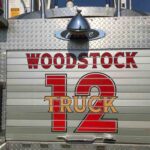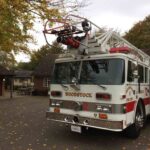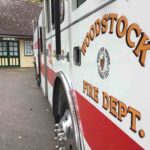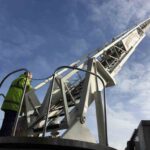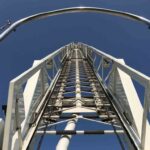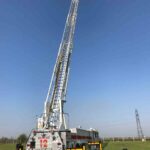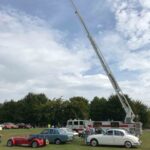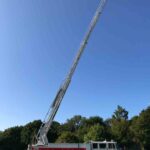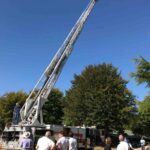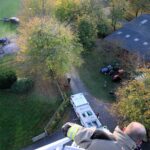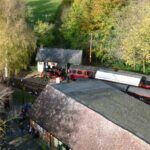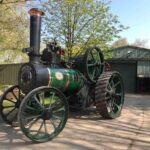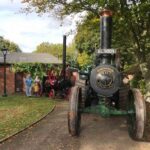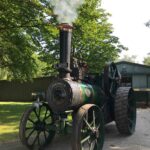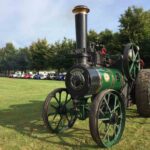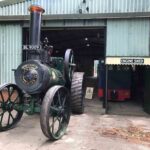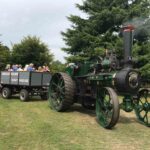Fire truck at BWLR
Arrived from the USA in October 2017, a 1991 Pierce Arrow aerial truck with 105 foot ladder.
This was designed and used, in Woodstock Virginia USA, as a high level rescue appliance and a means of delivering water to high or difficult locations.
It is capable of lifting 400lbs at full stretch 90 degrees to the truck or delivering 4000 Litres of water a minute from the nozzle at the top of the ladder.
The truck was taken out of service in September 2017 and was destined to be cut up.
Although completely different and much younger and other equipment saved in the past it is none the less important that some examples of these trucks survive.
Garrett Traction Engine
For almost a hundred years traction engines and steam rollers played an important role in road transport and construction with their use declining by 1940 as they were displaced by petrol and diesel powered vehicles.
At Bredgar we were custodian of three road locomotives each of which has an interesting history. In 2017 the Showman’s engine and the Road Roller were sold. In 2021 Tony Baker brought his Aveling and Barford steam roller to BWLR. It is now on display during event.
The Garrett traction engine is in full working order and is used on event days and for driving experiences.
GARRETT GENERAL PURPOSE TRACTION ENGINE 7NHP No.33442 was built by Garretts of Leiston in 1919 it was dispatched by rail on 13 August to Mr. Henry H. Baylis of Hatford Manor near Faringdon in Oxfordshire. The engine was sold through Garrett agents T. Baker of Compton, Berkshire.
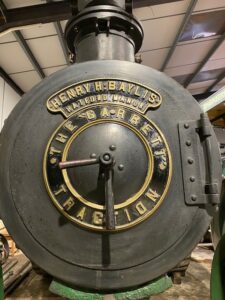 The original order was for a 7 nominal horse power single cylinder spring mounted traction engine with winding drum including 50 yards of 5/8 inch wire rope, fitted with an injector for maintaining boiler water levels (£6/4s/0d extra) and finished in standard green. The total cost including discounts and the optional extra injector was £976/10s/0d. Mr. Baylis’ name was to be on a brass plate fixed to the smoke-box door. Included in the price were the services of Garrett’s Demonstration driver for a week to train the local man. All major builders offered this service.
The original order was for a 7 nominal horse power single cylinder spring mounted traction engine with winding drum including 50 yards of 5/8 inch wire rope, fitted with an injector for maintaining boiler water levels (£6/4s/0d extra) and finished in standard green. The total cost including discounts and the optional extra injector was £976/10s/0d. Mr. Baylis’ name was to be on a brass plate fixed to the smoke-box door. Included in the price were the services of Garrett’s Demonstration driver for a week to train the local man. All major builders offered this service.
The Garrett was used for driving a threshing machine and hauling trailers. In 1943 it passed to a second owner, Wilcox & Frost, hay merchants of Witney. The use of traction engines declined after 1945 when they were replaced by tractors such as Field-Marshalls, examples of which are also preserved at Bredgar. The engine ended its working life relegated to steam heating greenhouses and sterilising soil at Rose of Carterton/Brize Norton.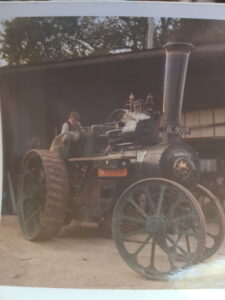
In about 1961 the engine was bought by Rowley (Bill) Jackson, despite his father telling him no one wanted steam any more! The engine was kept at the family business premises of R H Jackson, Haulage Contractor, Kilcot, Glos. He worked on it whenever he could and had started up The Ross on Wye Vintage Steam Engine Club with a few mates. By 1965 the engine was ready to show and he named it ‘King of the Road’. The song by Roger Miller was around that year and he ran the family haulage business so it must meant something to him. Bill sadly passed away in 1970.
Royley’s widow sold the engine to a local haulier, Richard Read, who renamed it after his wife, ‘Caraline’. Read sold it to a dealer, John Anderson of Eynsham, Oxon in the mid seventies it is believed. Barry started restoration work and and noted that the smoke box door was incorrect. It went through some other hands but reappeared Chiltern Clubs rally in 1985 – in steam. It was extensively rallied for 3 years.
The engine came to the Bredgar & Wormshill Light Railway in 1988. Some restoration work was 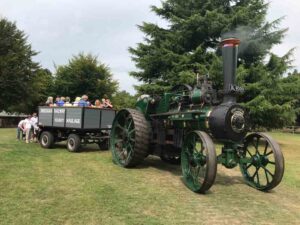 carried out in 1989 but in 1991 a full overhaul was undertaken with a new fire-box, boiler barrel and tubes. Boiler work was done by Bicknells of Liphook and the engine was then rebuilt at Bredgar. Mr. Baylis has confirmed it carried no name during its working life and with the Baylis family help we cast a copy of the smoke box plate to match the original as delivered when new. The engine is now used to haul visitors in the Bredgar Heavy Haulage trailer on open days.
carried out in 1989 but in 1991 a full overhaul was undertaken with a new fire-box, boiler barrel and tubes. Boiler work was done by Bicknells of Liphook and the engine was then rebuilt at Bredgar. Mr. Baylis has confirmed it carried no name during its working life and with the Baylis family help we cast a copy of the smoke box plate to match the original as delivered when new. The engine is now used to haul visitors in the Bredgar Heavy Haulage trailer on open days.
AVELING-BARFORD ‘W’ TYPE 10 TON STEAM ROLLER
AVELING-BARFORD ‘W’ TYPE 10 TON STEAM ROLLER, 1948 (owned by our engineer Tony since 1992)
This steam roller is the sole survivor of three ‘W’ type single cylinder steam rollers supplied new by Aveling-Barford to the order of the Great Western Railway. It was given builder’s number AH162, and despatched on 28 February 1948. It escaped scrapping by British Railways, and last worked with Messrs. Joseph Coles and Sons of West Town, Bristol.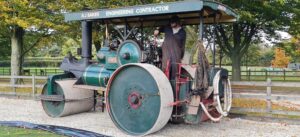
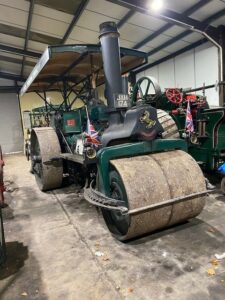 The roller was sold by them into preservation in 1962. Aveling-Barford were the last firm to supply new steam rollers to the British market. Manufacture of these rollers after the Second World War was sub-contracted to Vickers-Armstrong in Newcastle upon Tyne, as the Aveling-Barford works in Grantham were by then given over to diesel roller production. This steam roller is the last Aveling-Barford ‘W’ type made, and one of the last steam rollers to be sold new in Britain. The steam rollers sold by Aveling-Barford after this machine were all the smaller 8 ton ‘T’ type, and most went to Asia, the last being despatched there in 1950.
The roller was sold by them into preservation in 1962. Aveling-Barford were the last firm to supply new steam rollers to the British market. Manufacture of these rollers after the Second World War was sub-contracted to Vickers-Armstrong in Newcastle upon Tyne, as the Aveling-Barford works in Grantham were by then given over to diesel roller production. This steam roller is the last Aveling-Barford ‘W’ type made, and one of the last steam rollers to be sold new in Britain. The steam rollers sold by Aveling-Barford after this machine were all the smaller 8 ton ‘T’ type, and most went to Asia, the last being despatched there in 1950.
This roller embodies a number of unusual features, including a crosshead-driven feed pump and an optional Pickering governor. A differential is fitted as standard. Considerable use is made of welded fabrication (then a comparatively new technique) in the roller’s construction, notably the front and rear rolls, scarifier, and gear casings. The rolls are able to be filled with water ballast, increasing overall weight by more than a ton, which is useful when consolidating road base.
Automobiles
Our car collection has been reduced in recent years in favor of agricultural and railway items. We have kept two historic cars. We also play host to the visiting historic and classic vehicle clubs on some open days. We also host a classic car meet on the 3rd Sunday of the month throughout the summer.
Reliant ‘Prince Regent’
Built in 1949 Index – FO 5654. Reliant took over Raleigh’s design for three wheeled vehicles in 1935. This vehicle was found in a dismantled state in a collapsed garage in Wales. The restoration was started in 2005 and took two years to complete. The engine was rebuilt and is derived from an Austin 7. The bodywork was almost non existent but sufficient survived to be used as templates for new aluminium panels.
Bean 14 Model 6 Tourer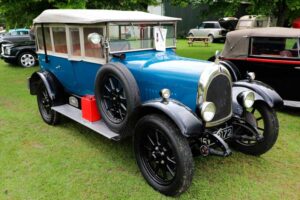
14 H.P. Built in 1923 Index – SV 9172. This car was exported in 1923 to Australia and then re-imported in 2001 by the Bredgar & Wormshill Light Railway. It has been used on Bean Car Club Rallies both locally and in France.
Tractors, Farm and Forestry Equipment
THE MARSHALL TRACTORS
Field-Marshall tractors were manufactured by Marshall, Sons & Co. of Gainsborough, Lincolnshire, England. The Marshall had a horizontal single cylinder two stroke diesel engine and were first produced in 1930. During WW2 the factory reduced tractor production due to being engaged in the manufacture of armaments. In 1945 Marshall’s introduced an improved tractor and henceforth called them Field-Marshalls.
Field-Marshalls with tracks were produced under the Fowler brand name in their factory at Leeds. The first were designated the “Fowler VF”, later ones being “VFA”s.
Of particular interest is the method of starting the two stroke diesel engine.
To start the Marshall a smouldering piece of special paper, containing saltpetre, is inserted into the cylinder head by means of the special screw-in holder (left hand photo). The engine is then turned over with a starting handle placed in the starting dog on the flywheel. This is aided by the decompression valve, which decompresses the engine for anything up to 6 revolutions (generally 3 revolutions is sufficient – a spiral groove on the perimeter of the flywheel is used to determine the number of revolutions and position before top dead centre where the decompressor mechanism disengages and permits compression) to allow the flywheel to gain speed and inertia to turn the engine through compression, and get the engine to fire.
A cartridge starting system is also fitted to the tractor. A shot-gun type cartridge, obviously without any shot (right hand photo) is loaded into a breech on the engine’s intake system. The smouldering paper is placed in the cylinder head, and the cartridge is fired by tapping the firing pin with a hammer. This puts a charge into the cylinder, sending the piston through its stroke, bursting the engine into life. This method, however, deposits carbon which often causes jamming of the decompression valve if cartridges are regularly used. It also puts significantly more strain on the engine.
FIELD-MARSHALL SERIES 3A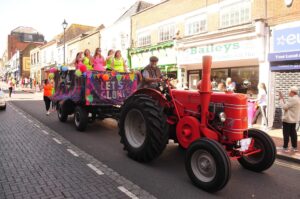
Chassis No. 16421. Registration No. 419 XUY. Like its forebears this series had a single cylinder horizontal two stroke diesel engine but improvements in design increased the power output to 40HP. It has a 3 speed and reverse gear box with high/low facility (providing 6 speeds) with a top speed of 11.3 m.p.h. These models were built from 1952 to 1956, 2125 units were made. This was the final single cylinder design as later tractors had conventional multi-cylinder engines with electric start.
Cost, £845 when new in 1954. This tractor and our Fowler VF were rebuilt in 2010 by Robert H Crawford & Son of Boston Lincs. who were Marshall agents from 1932 and still supply spares for these tractors. Right – Marshall pulling trailer float at 2014 Sittingbourne carnival.
FOWLER VF TRACK-MARSHALL
Marshall tractors we have a Fowler VF ‘crawler’ tractor. The tractor was overhauled prior to delivery to Bredgar by Crawford & Son of Boston, Lincs.
The Fowler VF is often referred to as a Field-Marshall on tracks, but in fact the Field-Marshall series 3 is a modified version of the Fowler VF. These models were built from 1948 to 1952 with 4658 units manufactured. This example (chassis No. 4704337) registration No. 58 RBM was built in 1951 at a cost of £1, 210 when new. It is fitted with a heavy duty winch.
John Fowler is of course the same company that built our two Fowler steam railway locomotives and one of the portables.
OTHER TRACTORS
Ford 3600 tractor
Registration No. VKE 257 X. These models were built from 1975 to 1981 and this model was first registered in 1981. It is a 3 cylinder diesel and has a narrower than usual wheel track as it is designed for orchard or vineyard work. This model was first supplied to a farm in the Bredgar area by Invicta Motors Ltd., of Canterbury, Kent.

